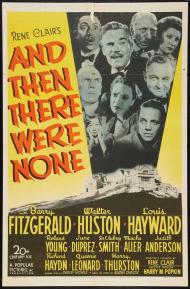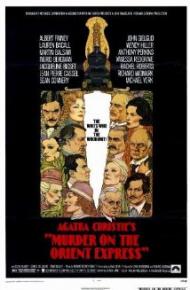Movie Review
Death on the Nile
The only thing that could follow 'Murder' is 'Death'.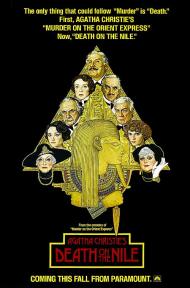
US Release Date: 09-29-1978
Directed by: John Guillermin
Starring▸▾
- Peter Ustinov, as
- Hercule Poirot
- Lois Chiles, as
- Linnet Ridgeway Doyle
- Simon MacCorkindale, as
- Simon Doyle
- Mia Farrow, as
- Jacqueline De Bellefort
- Jane Birkin, as
- Louise Bourget
- George Kennedy, as
- Andrew Pennington
- Bette Davis, as
- Marie Van Schuyler
- Maggie Smith, as
- Miss Bowers
- Angela Lansbury, as
- Salome Otterbourne
- Olivia Hussey, as
- Rosalie Otterbourne
- David Niven, as
- Colonel Johnny Race
- Jon Finch, as
- Mr. James Ferguson
- Jack Warden, as
- Dr. Bessner
- Celia Imrie, as
- Maid
- Harry Andrews, as
- Barnstable
- Sam Wanamaker, as
- Rockford
- I. S. Johar, as
- Mr. Chaudhry
- Saeed Jaffrey as
- a Servant
![3 star[s] out of 4](http://www.threemoviebuffs.com/static/images/global/featured_gold_stars.png)
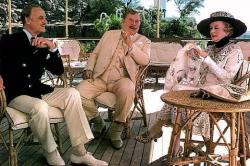
David Niven, Peter Ustinov and Bette Davis in Death on the Nile.
Thanks to the success of those all-star disaster movies it became common in 1970's Hollywood for producers to make big budget epics, set them in exotic locales, and fill them with as many famous movie stars of a certain age as possible. In 1974 John Brabourne and Richard Goodwin teamed up to produce a screen adaptation of Agatha Christie's Murder on the Orient Express, with Albert Finney as Hercule Poirot leading an all-star cast. It was a surprise hit, grossing a then impressive 25 million dollars at the domestic box office.
Naturally enough they re-teamed four years later for another go. This time they picked Christie's popular 1937 novel Death on the Nile (which they originally planned to call Murder on the Nile to more closely tie it in with the previous movie). When Finney declined the offer to reprise his role as Poirot, Peter Ustinov was chosen instead. He would go on to play the famous Belgian detective in five later movies during the 1980s.
The plot follows Agatha Christie's tried and true formula. Arrange to have an interesting and disparate group of near-strangers gather together in an isolated setting. In this case a paddle-steamer traveling down the Nile River in Egypt. A murder takes place. Everyone aboard has a motive for committing said murder. Hercule Poirot puts his “little gray cells” to solving the crime. The body count starts to climb. Finally, the detective gathers all the remaining suspects in one room and tells them, step by step, how and why each of the murders were committed and by whom.
The real joy in Death on the Nile is watching this amazing cast create these colorful characterizations.
Ustinov is perfect as the food and wine loving detective, constantly correcting everyone when they call him French, as they all invariably do. At the center of the story is a love triangle between characters played by Mia Farrow, Lois Chiles and Simon MacCorkindale. The cast also boasts three legendary actresses. Bette Davis plays a rich kleptomaniac traveling with her rather mannish personal assistant played by Maggie Smith. Angela Lansbury is an eccentric writer of soft-core erotica named Salome Otterbourne. Each of these divas tries their utmost to steal scenes, with Angela Lansbury winning by an eyelash. They each get juicy bits of dialogue to spout.
Bette Davis as Mrs. Van Schuyler: “Come, Bowers, it's time to go, this place is beginning to resemble a mortuary.” Maggie Smith as Miss Bowers: “Thank God you'll be in one yourself before too long you bloody old fossil!” And not to be outdone, Miss Lansbury as Salome Otterbourne gets to utter things like: “Frenchmen aren't afraid of good strong sex!”
Shot on location in Egypt, Death on the Nile includes some breathtaking shots of such ancient landmarks as the Great Pyramids, the Sphinx, and temples at Abu Simbel and Karnak. There are also many fantastic shots of the Nile and its surrounding landscape. Shooting was begun at 6 am as it had to be shut down for two hours during the heat of the day when temperatures could reach as high as 130 degrees Fahrenheit. Bette Davis famously observed, “In the older days, they'd have built the Nile for you. Nowadays, films have become travelogues and actors stuntmen.”
Death on the Nile was a hit, although not quite as big of one as its predecessor had been. It still grossed a respectable 14 million domestic. It won Anthony Powell an Oscar for Best Costume Design, thanks mostly to the clothes worn by the three above mentioned female legends. I remember when it premiered on HBO when I was a kid. Watching it today, I must say it holds up quite nicely. It's a bit slow to be honest but once the first murder occurs it remains engrossing right up to the final scene. The amazing cast in this remarkable setting combine to make it a memorable motion picture.
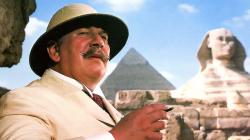
Peter Ustinov as Hercules Poirot in Agatha Christie's Death on the Nile.
I agree that this movie is memorable and enjoyable, but as with most sequels, it is inferior to the original in nearly every way. It is only in the scenery among the Egyptian ruins that Death on the Nile surpasses Murder on the Orient Express.
The biggest loss from the first film to the second is Albert Finney. Where he buried himself in the role of Poirot, Peter Ustinov plays the Belgian detective much less distinctly, toning down his eccentricities until they are almost entirely absent. Were it not for the accent and the twirled mustache, he could be playing any old detective. He's likeable and entertaining enough, but he fails to capture Christie's most famous creation.
With the treasures of Egyptian King Tutankhamen touring America in 1978, Egypt was a hot topic that year and this movie makes good use of the ruins of that country. The scenes at the Sphinx and the Pyramids and the Temples that my brother mentioned give the film a grander scope than its drawing room mystery would normally provide as the characters get up close and personal with several of these historic sites. The New York premiere of the film even took place at the Metropolitan Museum of Art, which would shortly be hosting the Tutankhamen exhibit.
Patrick mentioned the three divas in the film; Davis, Lansbury and Smith. They are definitely the most entertaining of the characters. Davis and Smith in particular get a few nice scenes together as they bicker and argue. Not to be outdone, Lansbury steals a few scenes as the drunken lush of a romance novelist. Both she and Davis seems to be having a "Who can dress the most like Norma Desmond?" costume contest and it doesn't surprise me to hear that Anthony Powell won the Costume Design Oscar after seeing the way those two are dressed. The younger cast do fine work and Lois Chiles has never looked more beautiful, but they are easily outshone by the elder actresses. The male characters are much less distinctive with David Niven being given little to do but follow Ustinov around and ask a few questions.
The solution to the mystery is less than satisfactory. The denouement feels too much like pure guesswork and the gathering together of so many people who are connected socially on a small boat in Egypt without being planned feels quite farfetched. And the criminal's plan relies too much on coincidence and chance.
It's not that this is a bad film and perhaps if I hadn't watched it so soon after watching Murder on the Orient Express I might have enjoyed it more. Watching the two side-by-side however, makes it all too plain which is the superior film. The producers managed to bring another big name cast together, but perhaps they should have also tried to get Sydney Lumet back to direct as well as Paul Dehn to write it.
![3 star[s] out of 4](http://www.threemoviebuffs.com/static/images/global/featured_gold_stars.png)
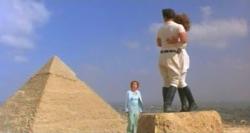
Mia Farrow, Simon Doyle and Lois Chiles using an ancient pyramid like a playground in Death on the Nile
The first thing I must agree with my brothers about is the incredible use of location shots of the Nile and the wonderful scenes taking place among, and on, some of Egypt’s most famous landmarks. I have always been fascinated by Egypt’s ancient history and would have thoroughly enjoyed the vacation experienced by the characters in Death on the Nile, that is, as long as I did not get murdered.
Peter Ustinov is acceptable as Hercule Poirot. As Scott wrote, he plays down Poirot’s idiosyncrasies that Albert Finney so milked. It was almost as if they forgot about them when writing the script and decided to add a few moments as an afterthought, such as the mustache mask he sleeps in.
Perhaps they played him with greater subtlety because so much of the rest of the cast is playing to the back row. My brothers mentioned the three divas, who each seem to be trying to out eccentric the other. Patrick noted a great line from each of them, while I will add, “…it has been my experience that men are least attracted to women who treat them well.” spoken by Bowers, giving a hint at her spinsterhood.
Hercule Poirot has a couple of great lines himself. When talking to Jacqueline about her desire to kill Linnet for taking her man, Poirot tells her, “Do not allow evil into your heart, it will make a home there.” He also sets up one of the funniest scenes in the movie. After being saved from a near snake attack, an unfazed Poirot points to the bathroom and tells the boat’s manager, “There is a dead cobra over there. Please do me the kindness of having it removed.” The manager finds the snake and says with some surprise, “Oh! Never have I seen such a reptile in a first class cabin!” I am guessing it is more common in second class. I also like the quote Poirot uses, by 17th Century French playwright Moliere, to end the film, “The great ambition of women is to inspire love.”
Although I was entertained while watching this film, I was let down by the setup and murder. Early in the film something did not feel right. As Scott noted, the coincidence of everyone having some sort of connection to each other was too big to ignore. Linette’s lawyer just happens to run into his client in a hotel dining room, in a foreign country! As this is a mystery, I cannot explain too much but after you know who the killer is, ask yourself if the killer did it at the right time and place?
What I am, mostly, taking away from Death on the Nile is the location setting. I wonder if access to the ancient structures is still so lenient. I have the feeling they are not. As a last note, the river boat featured here, or more likely one made to look like it, was also featured in The Mummy (1999). Both movies are intended to have taken place at similar times. Man may have long since spread out across the earth, but the cradle of civilization still seems like a fascinating place to return to, as long as you are not in the company of a murderer of course.
Photos © Copyright Paramount Pictures (1978)

